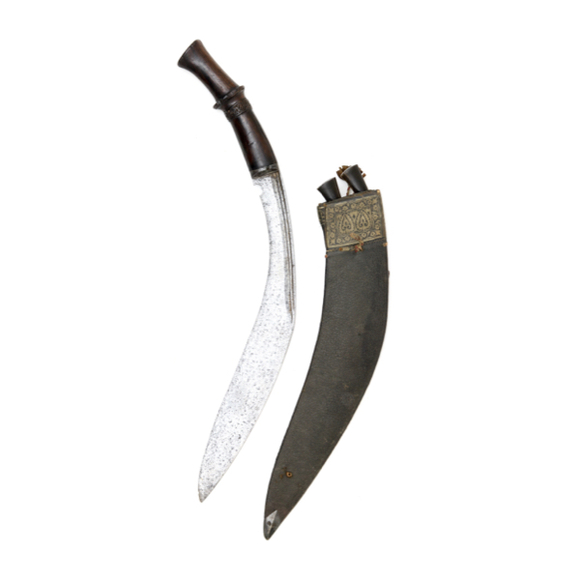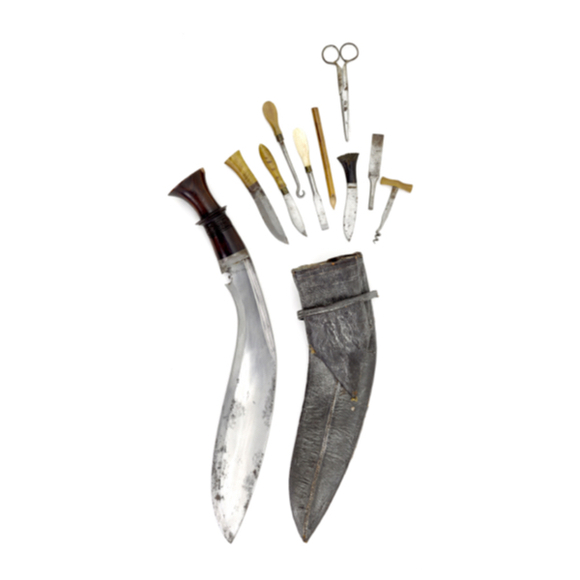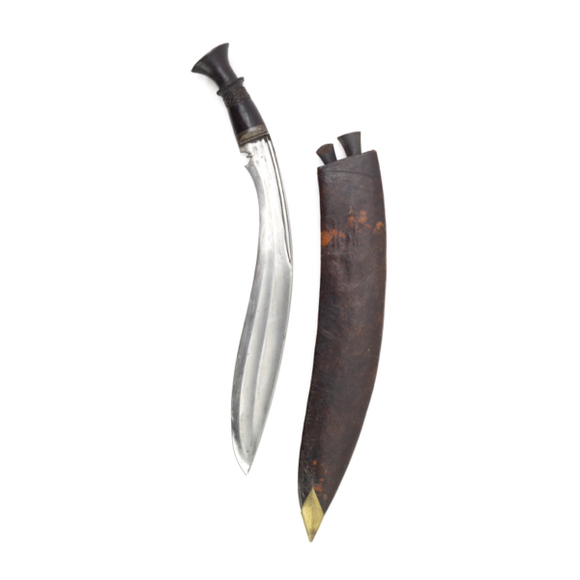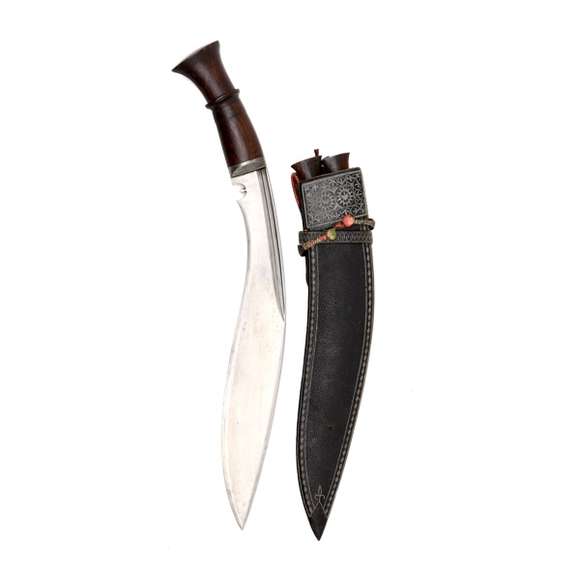Language: English
Origin: In common use among collectors
Description
Thur is the Tibetan word for a peculiar way of forging that was commonly used in the Himalayan region.1
It is known as "hairpin forging" or "hairpin laminations" among collectors, the name derives from the sharp bend the laminations take at the apex of the blade.
C.S. Smith referred to it as;
"side-by-side welding of a nested series of hairpin rods" 2
-
-

Well-executed hairpin forging on a fine Tibetan sword.
Sold by Mandarin Mansion in 2018.
Notes
1. Donald J. Larocca; Warriors of the Himalayas: Rediscovering the Arms and Armor of Tibet.
2. Cyril Stanley Smith; A History Of Metallography: The Development Of Ideas On The Structure Of Metals Before 1890. 1960.
Technique
The effect is achieved by using two different types of iron or steel; One higher carbon steel called pho lcags or "male iron" which was harder but more brittle and a lower carbon iron or steel called mo lcags or "female iron" which was softer but tougher.1
Combining steels of different carbon contents was common for bladesmithing in most cultures. What sets the Tibetan method apart is the arrangement of the layering. Instead of creating a laminate of higher and lower carbon steels from flat to flat, the layers are "stacked" from edge to spine.
The work was still done in 2016 in the village of Yiong, Nyingchi prefecture, Tibet;

A hairpin forged blade in the making, showing the pre-arrangement of the layers.
Source: Xinhua; Tibetan sword: The art of iron and fire.
Notes
1. Donald J. Larocca; Warriors of the Himalayas: Rediscovering the Arms and Armor of Tibet. Page 146.
My theory on the origin of hairpin forging
Forging swords is hard in the Himalayas, because the two main ingredients for a hot forge are in low supply: oxygen and fuel. Therefore, they probably were looking for a way to reduce the time they needed to heat their blades to welding temperature of around 900-1000 degrees. With regular forge folding, the steel is required to take this heat during each fold.
Tibetan blacksmiths probably were looking to get the advantages of a laminate construction of higher and lower carbon steels, without spending as much fuel.
When arranging it in a hairpin shape like this, you can do the basic shapes on a lower heat and then forge-weld the whole together in one go.
Variations
The usual method is one section of bends near the tip of the sword. In some occasions one sees two hairpins, one near the tip and one at the base. This I mostly associate with the southeastern part of Tibet, mainly the Kham region.



A Tibetan shortsword with a double hairpin forged blade.
Mandarin Mansion inventory 2023.
Another variation has the layers fold back on each other several times, forming a zig-zag pattern known as ce rong or "open ravines".1



Ce rong hairpin forging on a Tibetan shortsword.
Sold by Mandarin Mansion in 2016.
This technique is executed to perfection on a sword in the Royal Armories, accession number XXVIS.186. This sword is excellently photographed and described (better than on the museum website) in Larocca's "Warriors of the Himalayas".2
Another unusual form of Tibetan hairpin forging is the combination of hairpin laminations and "horse-tooth" forging, which shows in undulating effects near the edge. I have never seen the combination on a purely Tibetan sword, but occasionally on sabers.3

Rare Tibetan curved saber with hairpin / horse-tooth laminations.
Metropolitan Museum, accession number 2017.331a–c.
Ex Philip Tom collection.
Notes
1. This pattern was drawn by Tibetan artist Lobzen Tenzin, published in 1968 and described by him as ce rong. Donald Larocca tentatively translated the term as "open ravines". See Donald Larocca's An early Tibetan text on the connoisseurship of swords in The Armorer's Art: Essays in Honor of Stuart Phyrr, Mowbray Publishing, Inc. (October 5, 2014). Pages 89-105.
2. Donald J. Larocca; Warriors of the Himalayas: Rediscovering the Arms and Armor of Tibet. Page 161.
In other cultures
Hairpin forging was not confined to Tibet alone. It can be seen among others in neighboring Bhutan, Sikkim, and to some extent, also in Yunnan and Upper Burma.
Bhutan
Culturally extremely close to Tibet, and this shows on their blades. On many high-level Bhutanese blades, a mirror polish was preferred where the layering could only be faintly seen in relief. On other swords, sometimes an imitation hairpin pattern was carved, even though the blade has actual hairpin laminations in the steel.

A royal Bhutanese patag.
Sold by Mandarin Mansion in 2016.
Sikkim
Some of the ban swords carried by the Lepcha of Sikkim had hairpin forged blades, sometimes with dramatic tempering effects. It was an all-purpose tool, reportedly used as:
"plough, toothpick, table-knife, hatchet, hammer, and sword.".1
-Sir Joseph Dalton Hooker
Hooker was a botanist, adventurer, and close friend of Charles Darwin.
He traveled through the Himalayas and India between 1847–1851.

A fine Sikkim ban sword with hairpin blade.
Sold by Mandarin Mansion in 2019.
Yunnan
Iron from the mines of Yunnan was prized far and wide, and it formed one of the main sources of iron for most of the neighboring areas. Naturally, smiths of Yunnan started to produce blades in all kinds of styles, for Chinese, Vietnamese, Burmese, and Tibetan markets. They even supplied the pirate army of Coxinga with blades in the 17th century. Among the products were Tibetan-style swords for the local Tibetan population and perhaps also for export, Burmese dha, and probably every other blade imaginable. Here is a very interesting one I sold years ago, far from archetypical, but it shows what Yunnan smiths could do.

Zhibeidao with a spectacular blade.
Sold by Mandarin Mansion in 2017.
Upper Burma
In the northern part of Burma a peculiar sword was made that was traded widely in the region through barter. The local Burmese name for them was lin gin (လင်းကင်း).
It ended up in the hands among others Shan, Kachin, Naga, Mishmi, and Karen people. Collectors have erroneously attributed them to the Naga or Kachin. Period traveler Errol Grey clears up the matter in his travel accounts, and speaks of a people he calls the Tureng, a Jingpo subtribe that lived under Khamti Shan protection, who mainly produced these weapons and traded them under the name "Khamti dha".
"These dhas are made in four varieties:
(i) The streaked (or dorica mela as it is called in Assam),
having four lines running longitudinally down the blade.
(a) The spotted dha, having numerous black spots cover-
ing both sides of the blade, as if indented by being
hit by some pointed instrument, but really natural.
(3) The white dha, with a perfectly clear blade, without
spot or line.
(4) The black dha, a dirty, rough-looking blade, giving the
idea that the process of manufacture is not complete.
These weapons are about eighteen inches long in the blade, and are broader at the point than at the handle. They are ground to have an edge in the form of that of the chisel. With the handle a couple of such dhas weigh a little over two pounds.
The streaked dha is invariably worn by the nobility and gentry of the Hkamti country."
On these swords, the hairpin forging wasn't a necessity but purely a status symbol.

A "streaked dha" as worn by Hkamti nobility, showing the hairpin laminations.
Sold by Mandarin Mansion in 2021.
Nepal?
The only major Himalayan culture that lacks from this list is Nepal. They may not have faced the same fuel issues as the Tibetans, and their blade-forging techniques were more similar to those of India.






